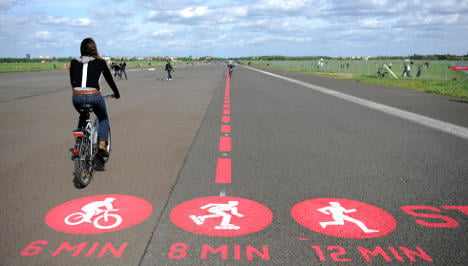Elysian (air)field
Only recently opened to the public as the city’s largest park, the abandoned Tempelhof airfield offers more than Nazi bullies in Hitler t-shirts and Kaiser’s A&P Summer Rave. Go for a run around the field and see for yourself… The vast emptiness of the expanse and its open skies (a stunning canvas for fluffy-clouded sunsets) may seem overwhelming at first, especially with the ghostly Tempelhof Airport – one part of Albert Speer’s Germania blueprints – lurking at the far end. But then you notice the signs: here there’s a “Dog Run”; a minute further on, a “German Weather Station” next to a “Bird-Breeding Habitat”; and, finally, the designated “BBQ Area”. All neatly explained in English, on bright-red signposts – a nod to the airport’s American past as the site of Berlin’s historic airlift? Even more impressive is the range of autonomous recreational use, even on mellow weekdays: joggers, rollerbladers, skateboarders and bikers spread out across the asphalt, but there’s still plenty of space for a game of inline hockey. Nearby, families are flying kites and some middle-aged geeks their model planes. By the time you reach the Biergarten, you’ll be sucking wind – circling the field requires advanced jogging skills – so take a break for a beer. This place has potential!/TJ
TEMPELHOFER FELD | Columbiadamm/Tempelhofer Damm, Neukölln, U-Bhf Boddinstr./U-Bhf Paradestr., 6–21:30
My beautiful laundrette
In a city in which everyone figuratively airs their dirty laundry, Berliners rarely wish to do so literally. Almost everyone owns a washing machine; those who don’t are treated to what feels like a poll tax to get our clothes cleaned (or, God forbid, dried) with prices that often appear to approach the cost of the garments themselves. Still, with a regular laundromat one can at least be left alone with one’s undergarments: a laundry café promises that most frightening encounter – a run-in with a German small-business owner. And the laundry café Mangelwirtschaft offers an experience considerably more crapulent than that. It sees no need to offer coherence or, for that matter, change for its machines. But this pales next to its insane insistence that it is not a laundromat but, as was explained to me in condescending English, a “private washing center”. Meaning that one is not allowed to do one’s laundry if one does NOT buy beer or cake or such… and you will be informed of this only after you’ve loaded your possessions into several of their small washers at €3 a pop. Because of the paucity of laundering options in my neighbourhood, I used to frequent Mangelwirtschaft on occasion. My final time there, while being reprimanded for not purchasing a cookie, I inquired of the proprietress – a woman whose defeated eyes appeared to reflect battered woman syndrome – whether she might reasonably wish for the commerce I was so willing to offer her. To which she replied, “You don’t even use us anyway! You use the laundromat down the street!” I don’t know if the stale pastries that surrounded her could ever soothe the broken heart of this failed capitalist – yet another example of the German inability to vaguely understand even the most elementary forms of customer service./DS
MANGELWIRTSCHAFT | Paul-Robeson-Str. 42, Prenzlauer Berg, S+U-Bhf Schönhauser Allee, Tel 030 6040 5767, Mon-Sat from 10:00 (last wash: 21:00), Sun from 12:00 (last wash: 19:00), www.mangelwirtschaft.com
Corporate slumworld
What does Africa stand for? Let’s think: wild animals, naked savages dancing to tribal bongos and, yes, of course, let’s not forget – shantytowns! So, to get as close to the 2010 World Cup as 10,000 km permits, why not build a slum-look-alike fun park? And since we’re too cool to really bother about intellectual integrity – and remember that we’ve been fighting loud and hard against Big Capital embodied by Mediaspree – let’s get our slum sponsored by… ADIDAS! That’s arguably what went through the übercreative brains of the unterprincipled Bar 25 people when they sat together with their sporty mega-corp partner: Johannesburg 24 was born (and such a smart name!). They traipsed around the city’s junkyards to scavenge the usual slum ingredients (cardboard, rusty containers, old car wheels and lots of corrugated iron) and deposited them on the Spree riverbank right next to Bar 25’s HQ, banged it all together as a rickety shantytown-style building complete with cool paintings of black people, and topped it off with a huge Adidas sign. And since no one really wants to sit in a real slum to watch soccer, the rest of Johannesburg 24 offers pretty much everything its mother business does: Sekt on the rocks for €5, long queues and, when Germany scores, lots of Bar 25’s signature confetti in the air. If you can stomach the €3 entrance fee in a city where most football public viewing spots are free, and get over the irritating marriage of the alternative “Spreeufer für Alle” claim and total sell-out to a multinational company, the atmosphere here is great during games, Deutschlandflaggen density pleasantly low, and, well, the setting on the sunny banks of the Spree is priceless. So go play in Berlin’s one and only township amusement park. It’s not gonna stay forever. What’s planned next? Spa 25 – for off-duty executives…/ALM
JOHANNESBURG 24 | Holzmarktstr. 24, Friedrichshain, S+U-Bhf Jannowitzbrücke, Mon-Sun 12-24, www.bar25.de/johannesburg



 Please whitelist us to continue reading.
Please whitelist us to continue reading.
Member comments